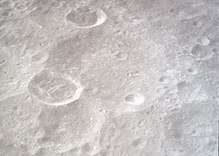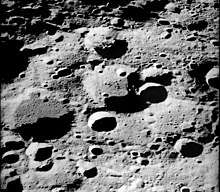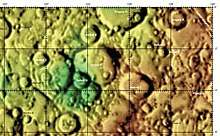Bečvář (crater)
Bečvář (Czech pronunciation: [ˈbɛtʃvaːr̝̊]) is a lunar impact crater that is located near the equator on the far side of the Moon. It was named after Czechoslovakian astronomer Antonín Bečvář.[1] It lies to the northeast of the crater Necho, within that feature's ray system. To the north-northeast is the crater Gregory.
 Oblique view of Bečvář from Apollo 17, facing north. Bečvář X is at top near center, Bečvář Q is below left of center, and Bečvář J is partially visible in lower right. | |
| Coordinates | 2.9°S 124.5°E |
|---|---|
| Diameter | 67 km |
| Depth | Unknown |
| Colongitude | 236° at sunrise |
| Eponym | Antonín Bečvář |

This is a worn, eroded crater system with a few tiny craterlets lying across the floor and rim. A double-crater formation occupies the southwestern rim, with Bečvář Q forming the northwestern member of this pair. The crater Bečvář X is attached to the northern rim.
Bečvář lies at the center of an unnamed, highly subdued, 200-km-diameter crater which was originally discovered during the Apollo 16 mission and reported by Farouk El-Baz. The name Necho was proposed for the crater, but the name was eventually adopted for the small, bright-rayed crater along the south margin of the unnamed crater.[2]
Satellite craters

By convention these features are identified on lunar maps by placing the letter on the side of the crater midpoint that is closest to Bečvář.
| Bečvář | Latitude | Longitude | Diameter |
|---|---|---|---|
| D | 1.5° S | 126.5° E | 15 km |
| E | 2.0° S | 127.8° E | 15 km |
| J | 3.6° S | 126.6° E | 45 km |
| Q | 2.9° S | 124.0° E | 28 km |
| S | 3.0° S | 121.1° E | 14 km |
| T | 1.8° S | 121.9° E | 27 km |
| X | 0.6° S | 124.2° E | 26 km |

References
- "Bečvář (crater)". Gazetteer of Planetary Nomenclature. USGS Astrogeology Research Program.
- Apollo 16 Preliminary Science Report (NASA SP-315), 1972, Chapter 29, Part H: Discovery of Two Lunar Features
- Andersson, L. E.; Whitaker, E. A. (1982). NASA Catalogue of Lunar Nomenclature. NASA RP-1097.CS1 maint: ref=harv (link)
- Bussey, B.; Spudis, P. (2004). The Clementine Atlas of the Moon. New York: Cambridge University Press. ISBN 978-0-521-81528-4.CS1 maint: ref=harv (link)
- Cocks, Elijah E.; Cocks, Josiah C. (1995). Who's Who on the Moon: A Biographical Dictionary of Lunar Nomenclature. Tudor Publishers. ISBN 978-0-936389-27-1.CS1 maint: ref=harv (link)
- McDowell, Jonathan (July 15, 2007). "Lunar Nomenclature". Jonathan's Space Report. Retrieved 2007-10-24.CS1 maint: ref=harv (link)
- Menzel, D. H.; Minnaert, M.; Levin, B.; Dollfus, A.; Bell, B. (1971). "Report on Lunar Nomenclature by the Working Group of Commission 17 of the IAU". Space Science Reviews. 12 (2): 136–186. Bibcode:1971SSRv...12..136M. doi:10.1007/BF00171763.CS1 maint: ref=harv (link)
- Moore, Patrick (2001). On the Moon. Sterling Publishing Co. ISBN 978-0-304-35469-6.CS1 maint: ref=harv (link)
- Price, Fred W. (1988). The Moon Observer's Handbook. Cambridge University Press. ISBN 978-0-521-33500-3.CS1 maint: ref=harv (link)
- Rükl, Antonín (1990). Atlas of the Moon. Kalmbach Books. ISBN 978-0-913135-17-4.CS1 maint: ref=harv (link)
- Webb, Rev. T. W. (1962). Celestial Objects for Common Telescopes (6th revised ed.). Dover. ISBN 978-0-486-20917-3.CS1 maint: ref=harv (link)
- Whitaker, Ewen A. (1999). Mapping and Naming the Moon. Cambridge University Press. ISBN 978-0-521-62248-6.CS1 maint: ref=harv (link)
- Wlasuk, Peter T. (2000). Observing the Moon. Springer. ISBN 978-1-85233-193-1.CS1 maint: ref=harv (link)
